Djibouti is an East African nation located in the Horn of Africa, and is home to an array of beautiful and diverse bird species. With its ample coastline and diverse terrain, the country offers a unique habitat for many species of birds.
From the magnificent Ostrich to the graceful Pelican, Djibouti is a haven for birders, who come from all over the world to observe these amazing creatures. This article will explore the different species of birds that can be found in Djibouti, as well as the various habitats they inhabit.
1. Bustard
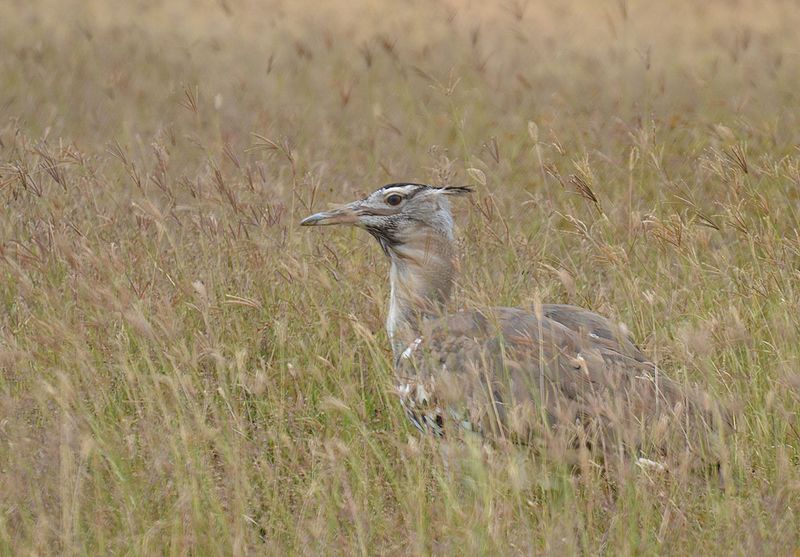
Bustards are large, terrestrial birds that inhabit dry grassland areas and the steppes of the Old World. They range from 40-150 cm in length and belong to the family Otididae.
Bustards have an omnivorous diet consisting of leaves, buds, seeds, fruit as well as small vertebrates and invertebrates.
These birds usually live a solitary life but can be seen gathering around water sources or food during certain times of year such as mating season.
Due to their large size they are vulnerable to predation by foxes or other animals which is why they tend to remain alert at all times.
When in open spaces while relying on camouflage for protection against predators when out in tall vegetation coverings.Scientific classification:
| Kingdom | Animalia |
| Phylum | Chordata |
| Class | Aves |
| Clade | Otidimorphae |
| Order | Otidiformes Wagler, 1830 |
| Family | Otididae Rafinesque, 1815 |
2. Sandgrouse
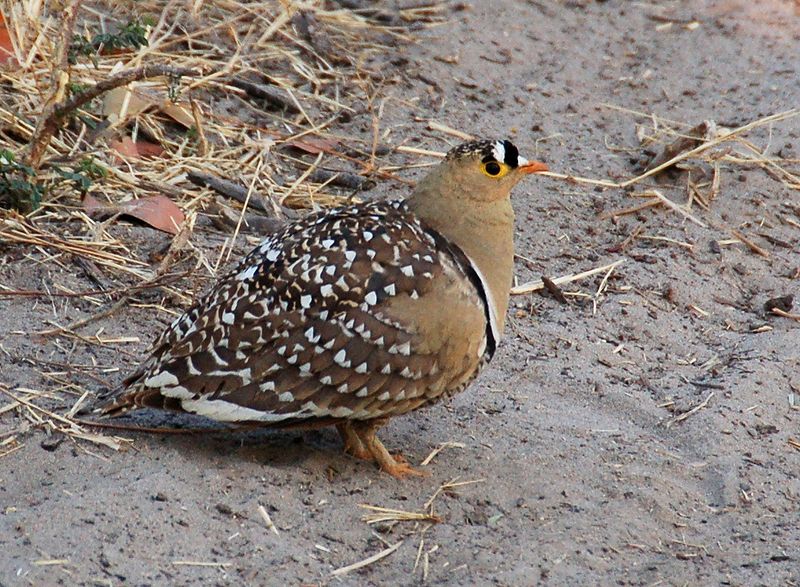
Sandgrouse is birds of the order Pterocliformes, found mainly in Africa and Asia. There are sixteen species belonging to two genera – Syrrhaptes from central Asia and Pterocles from Africa and other Asian countries.
They inhabit treeless areas such as deserts, steppes, scrubland, or savannas and tend to be ground-dwelling birds that feed on seeds.
Sandgrouse has adapted special features for survival in their harsh environment.
They possess well-developed feet with four toes used for walking over hot sand while keeping their body temperature cool at all times by regulating heat loss through their legs.
Their feathers also act like a sponge helping them absorb water before flying long distances back home where they then expel it using specialized glandular secretions located near the wings so that chicks can drink directly from an adult’s breast plumage.Scientific classification:
| Kingdom | Animalia |
| Phylum | Chordata |
| Class | Aves |
| Clade | Columbimorphae |
| Order | Pterocliformes Huxley, 1868 |
| Family | Pteroclidae Bonaparte, 1831 |
3. Mousebird
Mousebirds are a family of small, long-tailed birds found in Africa. They have slender bodies and short legs with four toes on each foot.
The wings are relatively large compared to the body size, giving them an agile and acrobatic flight ability.
Mousebirds can be recognized by their distinctive coloring; they usually have grayish heads and necks with brown or black backs, white bellies, bright blue rumps, green wings tipped in yellow feathers and dark red tails.
Their diet consists mainly of fruits but they will also eat insects such as grasshoppers or beetles when available.
They typically live in pairs or small groups that roost together during the night for protection from predators like owls and hawks.
These social creatures use vocalizations to communicate within their group as well as between different mousebird families living near one another.
4. Crab-Plover
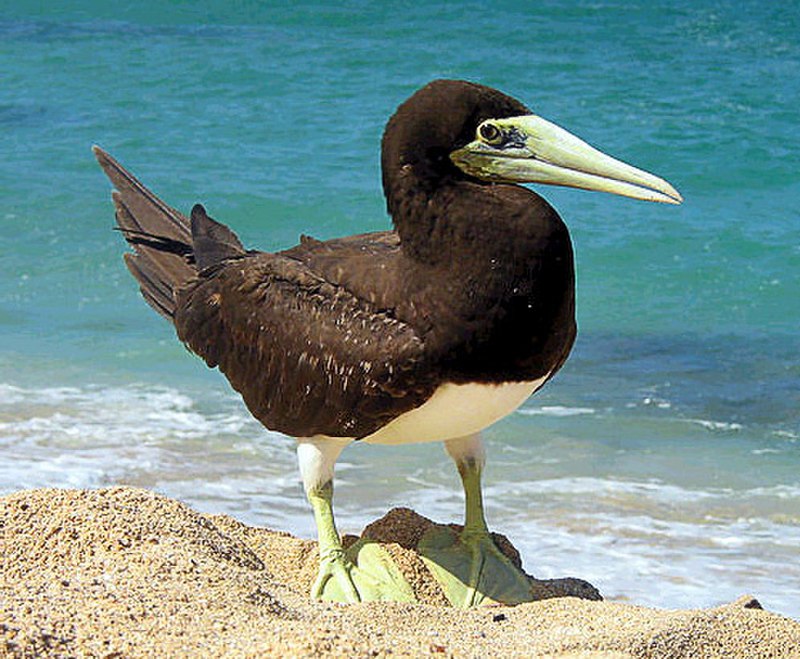
The crab-plover is an exceptional bird which belongs to its own family, Dromadidae. It appears to be closely related to the waders and other Charadriiformes such as auks, gulls and thick-knees.
This species of bird has a unique look; it is white with black markings on its head and wings. Its long bill helps them dig for food in sand or mudflats.
They can also fly up into the air when disturbed by predators or people too close for comfort.
The crab plover spends most of its life near beaches where they feed on crabs, fish eggs and small insects found there.
These birds are highly social during breeding season but solitary at other times throughout their annual cycle making them difficult creatures to spot out in the wild but well worth trying.Scientific classification:
| Kingdom | Animalia |
| Phylum | Chordata |
| Class | Aves |
| Order | Charadriiformes |
| Suborder | Lari |
| Family | Dromadidae GR Gray, 1840 |
| Genus | Dromas Paykull, 1805 |
| Species | D. ardeola |
5. Djibouti Spurfowl
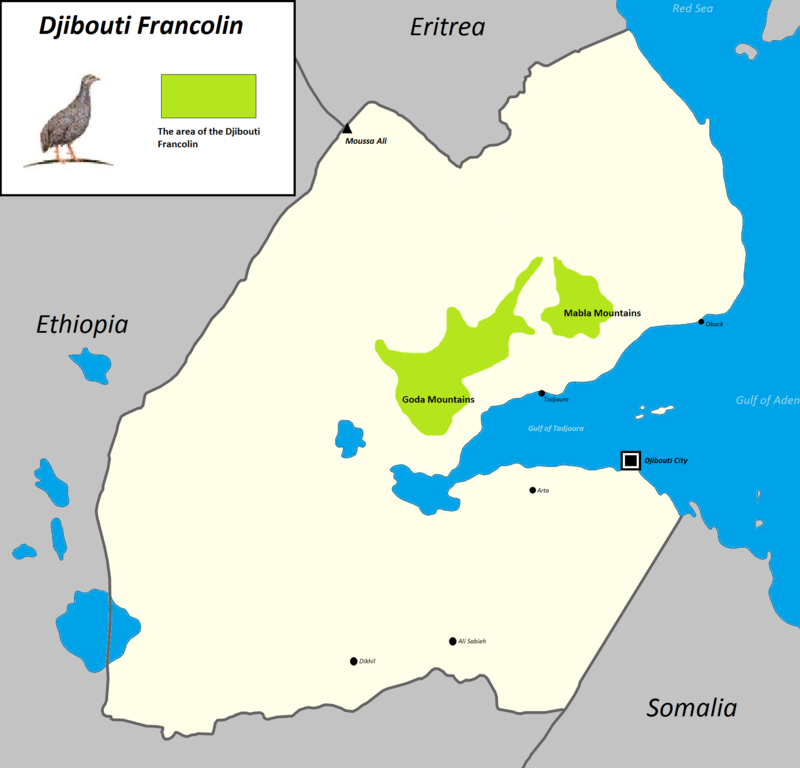
The Djibouti spurfowl is a critically endangered species of bird found only in the nation of Djibouti, located on the Horn of Africa.
This unique bird has grayish-brown feathers with white stripes and streaks that become finer as they move towards its upperparts.
Its head sports black markings while its crown is grey in coloration. The wings are relatively short but wide which allows it to fly low along grassy areas where it feeds on seeds, fruits and insects.
It nests primarily in shallow depressions among rocks or bushes during dry season when food sources are more abundant for adults and chicks alike.
A once common sight across much of East Africa, this beautiful native species now faces an uncertain future due to habitat destruction caused by human activities such as deforestation and overgrazing from livestock herdsScientific classification:
| Kingdom | Animalia |
| Phylum | Chordata |
| Class | Aves |
| Order | Galliformes |
| Family | Phasianidae |
| Genus | Pternistis |
| Species | P. ochropectus |
6. Sylviid Warblers
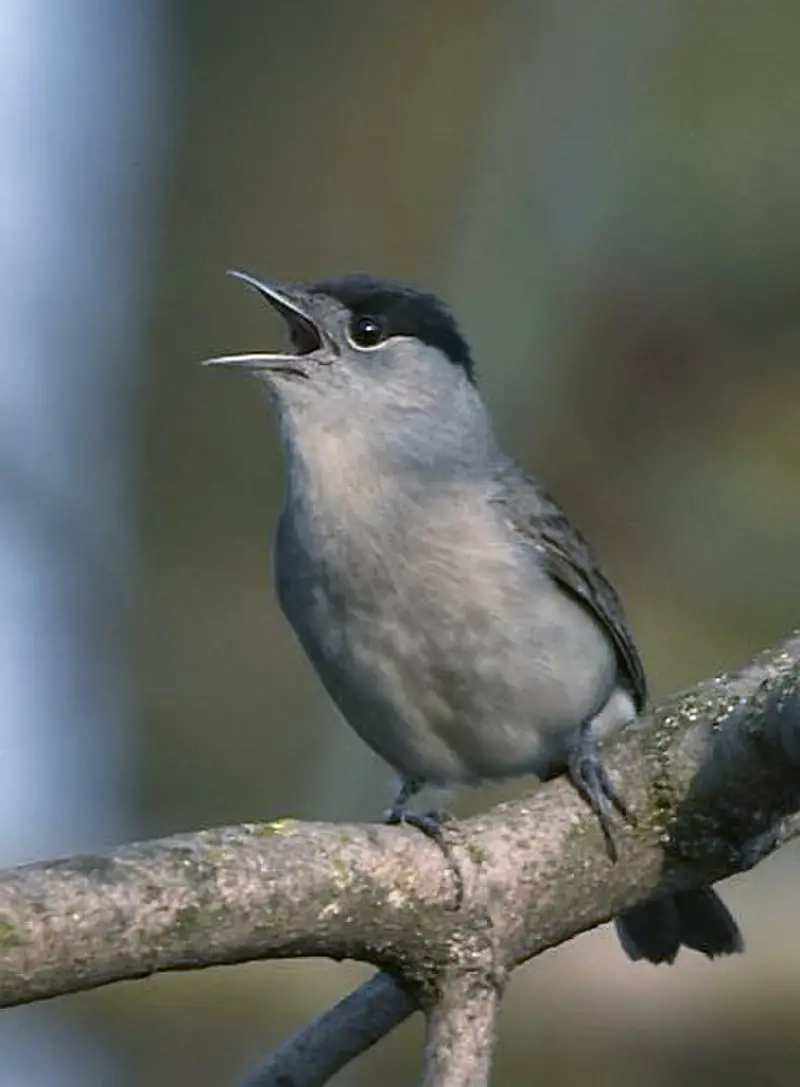
The Sylviid warblers are a family of passerine birds found in Eurasia and Africa. They include the typical warblers as well as babblers that were formerly part of the Old World babbler family.
These birds have slender bodies, pointed wings, long tails and strong legs adapted for ground-dwelling habits like running or hopping along branches.
The male often has bright colors while females are usually duller in coloration with more muted plumage patterns than males.
Some species also show sexual dimorphism where one sex may be larger or smaller than its counterpart; for instance some species may have longer tail feathers on the female side compared to their male counterparts.
Many members of this group feed on insects but some specialize on seeds, fruits, nectar or even frogs.Scientific classification:
| Kingdom | Animalia |
| Phylum | Chordata |
| Class | Aves |
| Order | Passeriformes |
| Superfamily | Sylvioidea |
| Family | Sylviidae Leach, 1820 |
7. Wattle-Eye
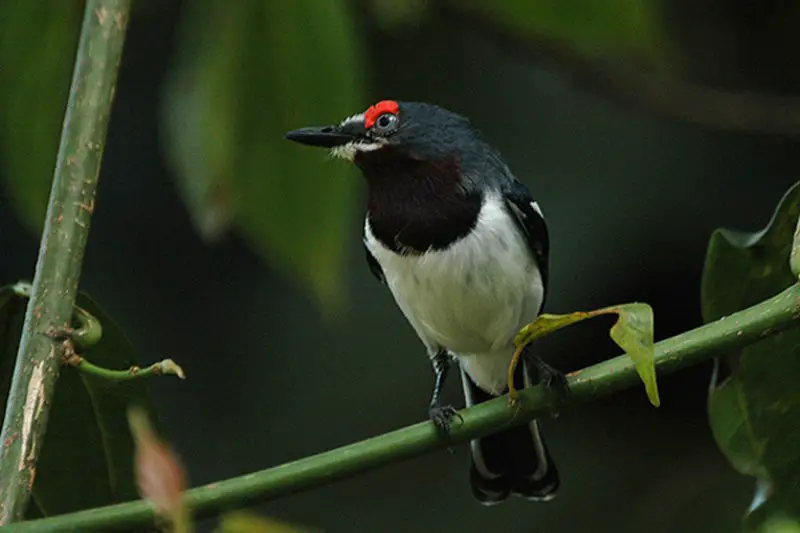
The wattle-eye, a member of the Platysteiridae family, is an insect-eating bird native to Africa.
It has a stout body and small head with bright yellow eyes surrounded by black patches or ‘wattles’.
They are usually seen in open forests or bushland where they hunt for insects either on the ground like shrikes do, or by flycatching from low perches.
Their nest is typically built in trees using twigs and leaves to form cup shaped structures lined with grasses and feathers which insulate their eggs during incubation periods.
Wattle-eyes can be recognised easily due to their distinct colours; males have greyish underparts while females display olive green hues with white speckled breast feathers that become more vibrant when breeding season begins.Scientific classification:
| Kingdom | Animalia |
| Phylum | Chordata |
| Class | Aves |
| Order | Passeriformes |
| Superfamily | Malaconotoidea |
| Family | Platysteiridae Sundevall, 1872 |
8. Bushshrike
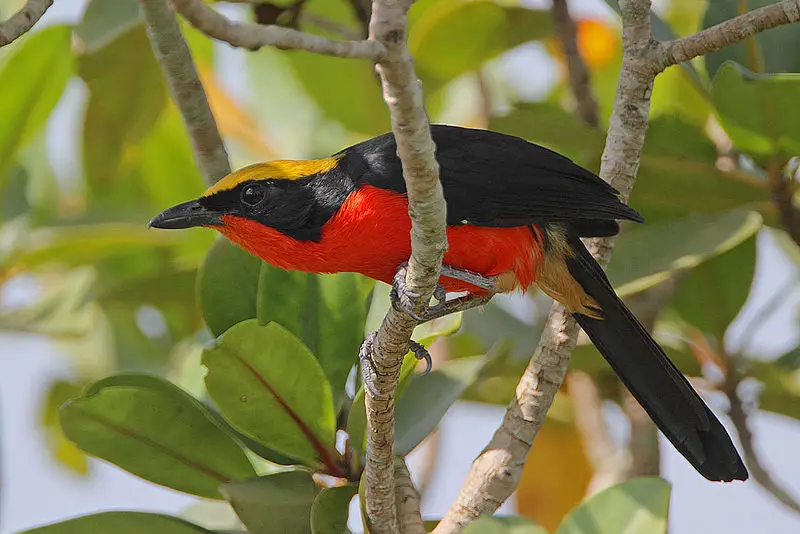
Bushshrikes are a family of small passerine birds native to Africa. Their ruffled back and rump feathers distinguish them from other shrike-like relatives, such as helmetshrikes.
They have bright plumages that vary in color depending on the species, but typically feature black wings with white or yellow markings.
Bushshrikes feed mainly on insects while also occasionally consuming fruits, berries and seeds.
They often hunt by perching atop tall trees and scanning for prey before swooping down upon their target when spotted.
During breeding season males sing melodious songs to attract mates while females build nests in dense foliage near the forest floor using sticks, leaves and grasses lined with soft mossy material or fur plucked from dead animals.Scientific classification:
| Kingdom | Animalia |
| Phylum | Chordata |
| Class | Aves |
| Order | Passeriformes |
| Superfamily | Malaconotoidea |
| Family | Malaconotidae Swainson, 1824 |
9. Stilts And Avocets
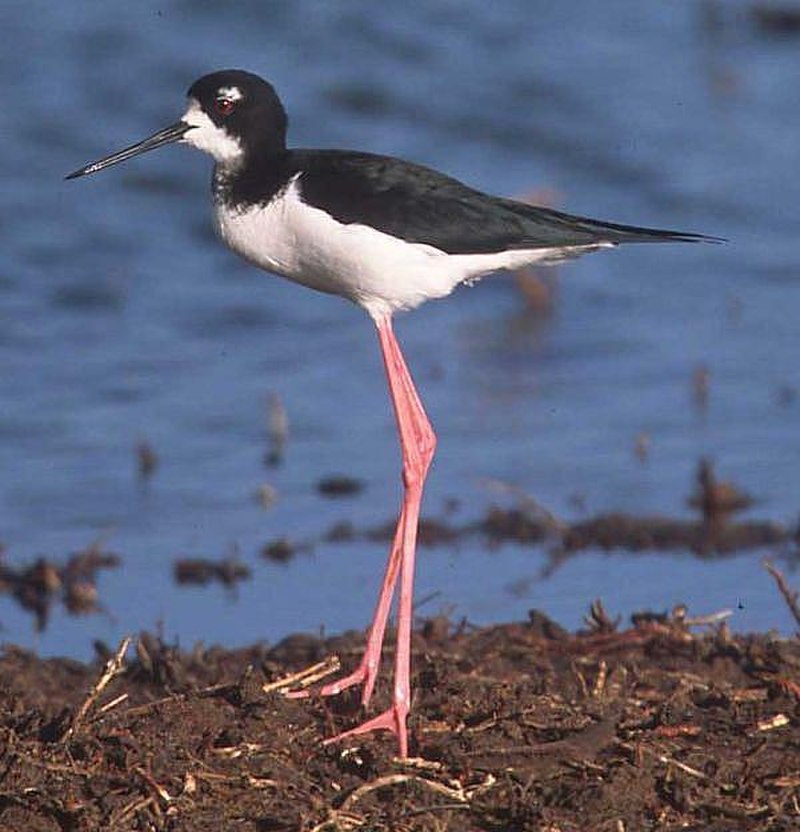
Stilts and avocets are two distinct groups of birds belonging to the family Recurvirostridae. They range in length from 30-46 cm (12-18 inches) and weigh between 140 – 435 g (4.9 – 15.3 ounces).
Males usually have slightly larger bodies than females, with long thin legs, necks and bills.
Avocet bills curve upwards uniquely while stilt beaks remain straight most times.
These wading birds live mainly near shorelines or wetlands where they feed on aquatic invertebrates like brine shrimp, insects etc., occasionally supplementing their diet with seeds or small fish too.
Stilts also inhabit open fields in search of food sources such as earthworms or grasshoppers during the non-breeding season.
Both groups migrate over large distances for warmer weathers when it gets cold outside.Scientific classification:
| Kingdom | Animalia |
| Phylum | Chordata |
| Class | Aves |
| Order | Charadriiformes |
| Suborder | Charadrii |
| Family | Recurvirostridae Bonaparte, 1854 |
10. Glareolidae
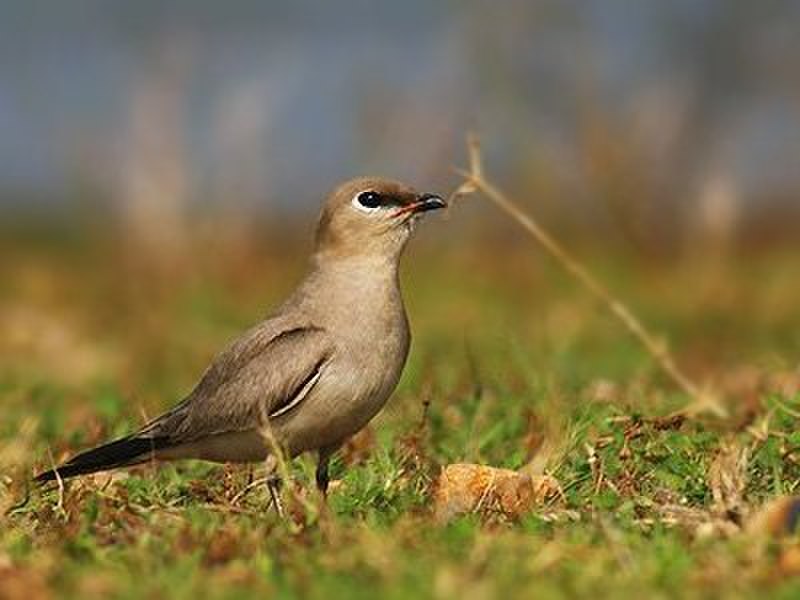
Glareolidae is a family of wading birds, consisting of four genera and 17 species. They are distinguished from other charadrii by their long bills which have a slight downward curve.
Glareolidae live around open grasslands and deserts, where they hunt for insects using the bill to probe into soil or vegetation.
Most species are found in Africa but two pratincoles inhabit parts of Europe and Asia as well.
Coursers tend to be larger than pratincoles with longer legs allowing them to run quickly across sandy dunes while feeding on small animals like lizards or spiders.
Pratincoles feed mainly on flying insects, snatching them out of midair with great agility during flight.
All glareolids share unique features such as large eyes that help it spot prey at night easily making this group one interesting bird family.Scientific classification:
| Kingdom | Animalia |
| Phylum | Chordata |
| Class | Aves |
| Order | Charadriiformes |
| Suborder | Lari |
| Family | Glareolidae CL Brehm, 1831 |
11. Cisticolidae
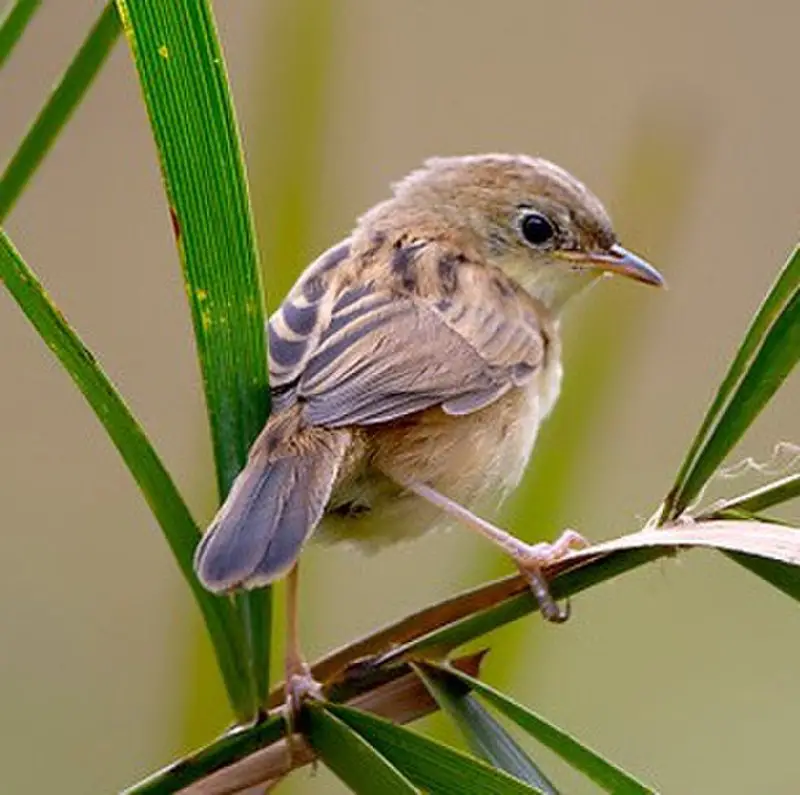
Cisticolidae is a family of warblers found mainly in warmer regions of the Old World. There are about 160 species all together, mostly seen across Africa but also in other parts like tropical Asia and Australasia.
One notable example from this family is the zitt bird which makes its home across these areas.
These small passerine birds have drab colors on their bodies with darker wings and tails for camouflage when they fly or perch among foliage.
They can be distinguished by their loud chirps that echo through forests and grasslands as well as distinctive songs used to attract mates during mating seasons.
Despite being quite common, Cisticolidae remain elusive due to their excellent ability to hide away within vegetation making them difficult to observe closely in nature.Scientific classification:
| Kingdom | Animalia |
| Phylum | Chordata |
| Class | Aves |
| Order | Passeriformes |
| Superfamily | Sylvioidea |
| Family | Cisticolidae Sundevall, 1872 |
12. Lybiidae
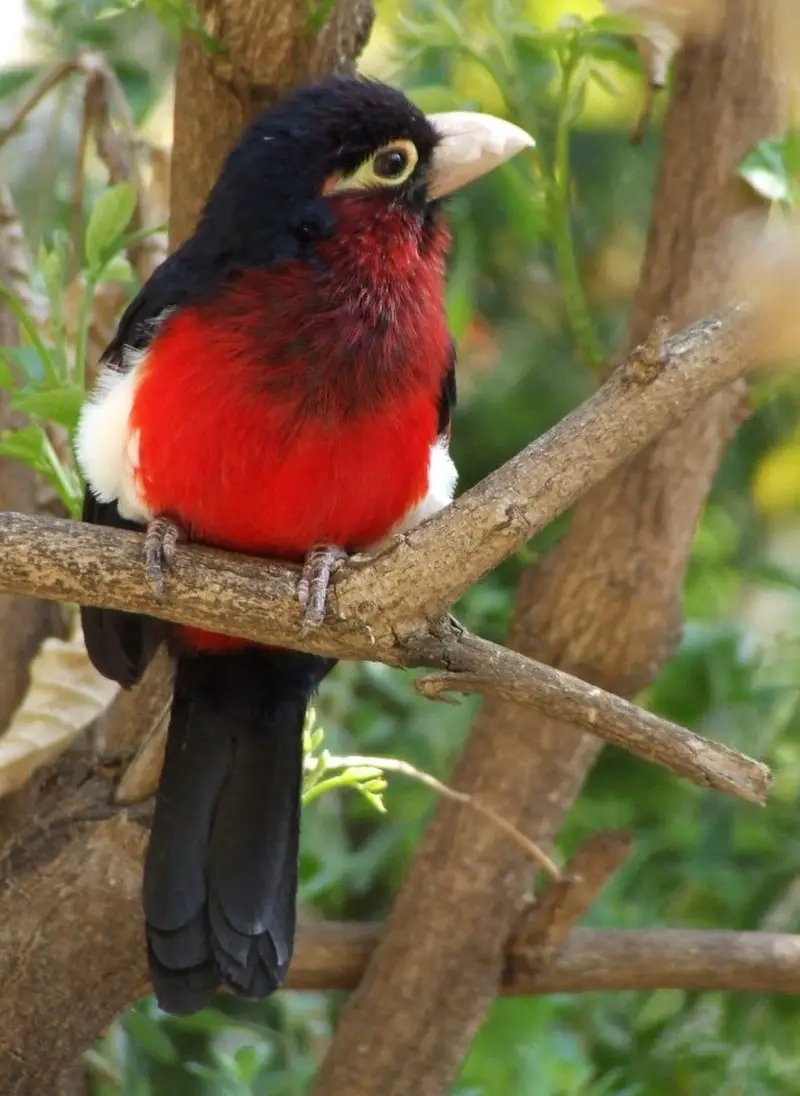
African barbets, belonging to the family Lybiidae, are a large group of birds found throughout sub-Saharan Africa.
They come in different sizes and inhabit various habitats from forests interiors to scrublands.
The Trachyphoninae species live mainly in the southern Sahara desert up until South Africa.
These colourful birds have distinctive features such as their short neck and stout bill that is used for cracking open hard nuts or drilling into tree bark for food.
Some African barbet species are important pollinators of flowers due to their diet consisting mostly on fruits and nectar which forces them to visit many plants daily.
Their bright calls can be heard throughout the day making them easily recognisable by humans too.Scientific classification:
| Kingdom | Animalia |
| Phylum | Chordata |
| Class | Aves |
| Order | Piciformes |
| Infraorder | Ramphastides |
| Family | Lybiidae Sibley & Ahlquist, 1985 |
13. Macrosphenidae
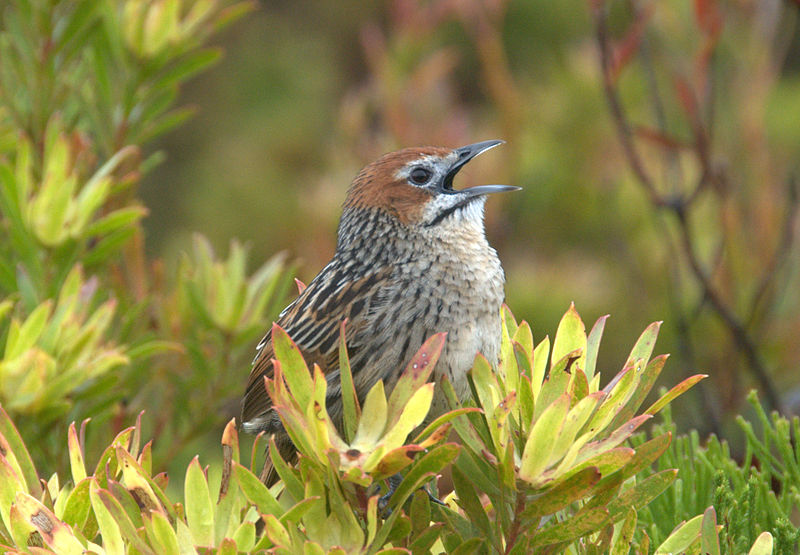
Macrosphenidae is a newly erected family of songbirds, mostly found in Africa and formerly placed under the Old World Warbler Family Sylviidae.
The Rockrunner or Chaetops frenatus was moved to the Babbler Family Timaliidae.
Molecular studies have revealed that this group belongs to the superfamily Sylvioidea which includes Larks, Swallows and Titmice etc.
These birds are small with long legs & short wings giving them an upright posture when perched on branches for singing their beautiful songs.
They feed mainly on insects but also eat some fruits & seeds from trees and shrubs.
Their habitat consists of open woodland or scrubland areas where they can find plenty of food sources as well as places to sing loud enough to attract mates during breeding season.Scientific classification:
| Kingdom | Animalia |
| Phylum | Chordata |
| Class | Aves |
| Order | Passeriformes |
| Superfamily | Sylvioidea |
| Family | Macrosphenidae Wolters, 1983 |
14. Drongos
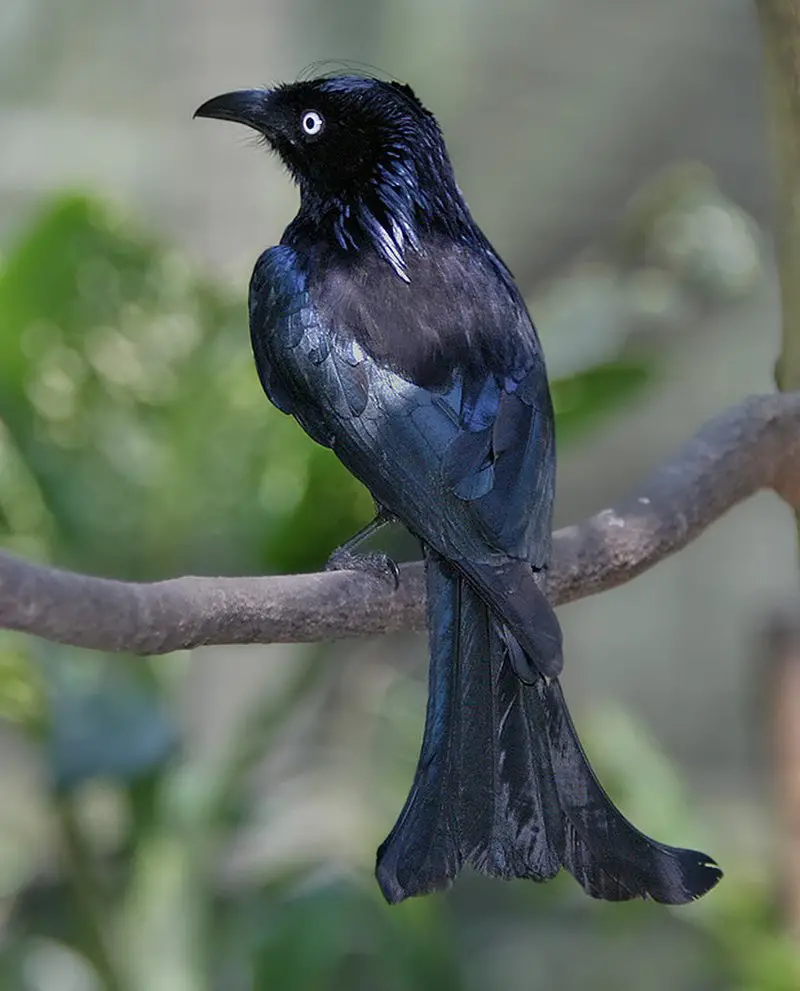
Drongos are an Old World tropical family of passerine birds belonging to the Dicruridae genus.
They have short legs, forked tails and a distinctive upright stance when perched.
Depending on the species they may be mostly black or dark grey in colour with some having elaborate tail decorations.
Drongos feed mainly on insects and small birds – catching them both in flight and from the ground.
They also sometimes eat fruit, nectar and even carcasses.
The drongo’s unique adaptations make it one of nature’s most successful hunters; able to survive almost anywhere in their natural range across Africa, Asia & Australia.Scientific classification:
| Kingdom | Animalia |
| Phylum | Chordata |
| Class | Aves |
| Order | Passeriformes |
| Superfamily | Corvoidea |
| Family | Dicruridae Vigors, 1825 |
| Genus | Dicrurus Vieillot, 1816 |
15. Monarch Flycatcher
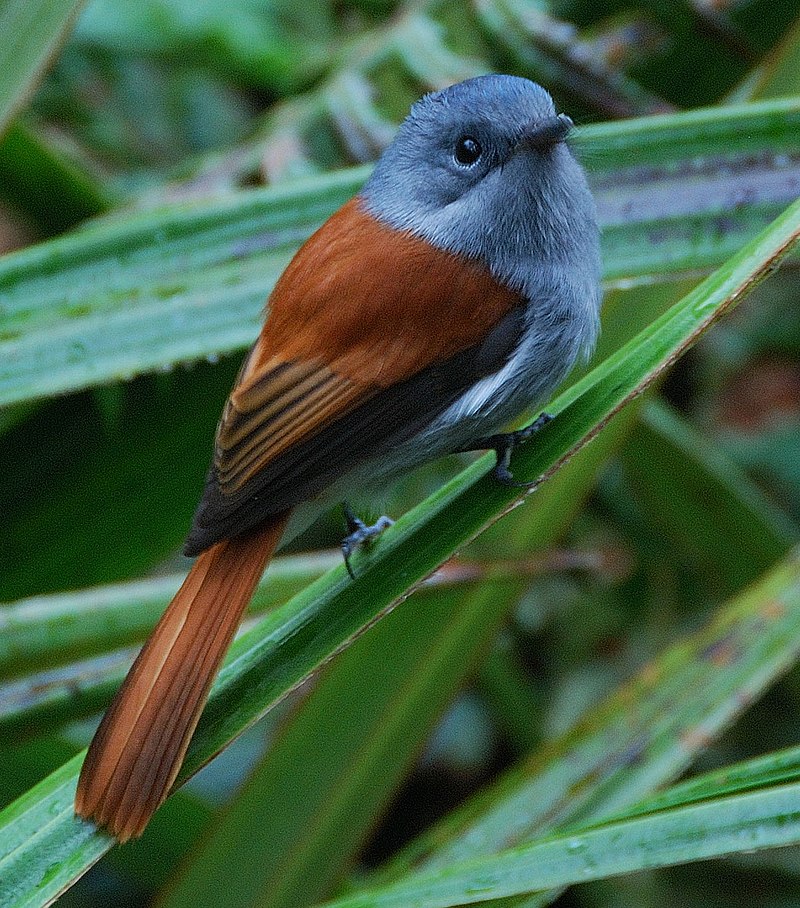
The Monarch flycatcher is a small passerine bird, belonging to the family Monarchidae. It inhabits forest or woodland areas across sub-Saharan Africa, south-east Asia, Australasia and various Pacific islands.
Only some species migrate seasonally. This beautiful little bird has a long tail and feeds mainly on insects it catches in its beak.
Its cup shaped nest can often be found hanging from branches high up in trees where they are safe from predators while incubating their eggs – usually between two to four of them at once.
The adult birds have attractive plumage with hues of blues and greens along with white patches near their tails which make for stunning displays when they take flight during mating season or migratory times.Scientific classification:
| Kingdom | Animalia |
| Phylum | Chordata |
| Class | Aves |
| Order | Passeriformes |
| Superfamily | Corvoidea |
| Family | Monarchidae Bonaparte, 1854 |
16. Laughingthrushes
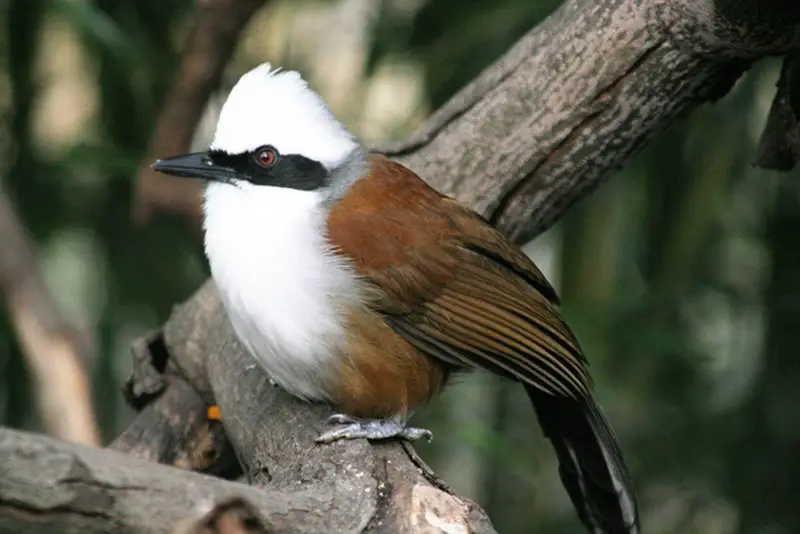
Laughingthrushes are a family of passerine birds found in tropical areas, primarily Southeast Asia and the Indian subcontinent.
They vary greatly in size and coloration but generally they have strong legs and many species are terrestrial or semi-terrestrial.
These birds typically inhabit forests where they feed on insects, fruits, seeds and occasionally small vertebrates.
The diet varies depending on the species as some prefer to forage among foliage while others look for food along the forest floor or take it from trees high up in their habitat.
In general these active creatures live in flocks that can range from just a few individuals to large groups with dozens of members making them quite vocal at times.Scientific classification:
| Kingdom | Animalia |
| Phylum | Chordata |
| Class | Aves |
| Order | Passeriformes |
| Superfamily | Sylvioidea |
| Family | Leiothrichidae Swainson, 1832 |
17. Arabian Bustard
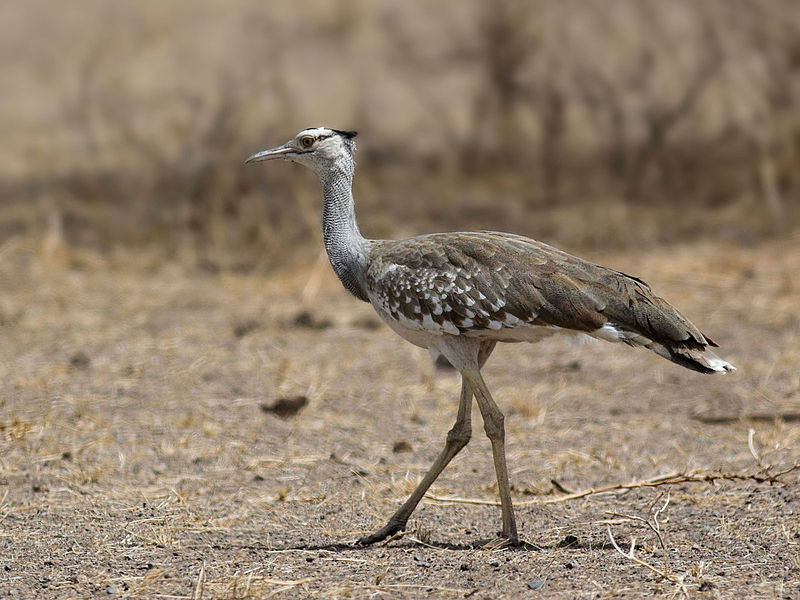
The Arabian bustard is a species of bird found in the Sahel region of Africa and south western Arabia. It belongs to the large-bodied genus Ardeotis, which makes it quite typical for its group.
In 1743, George Edwards was first to describe and illustrate this fascinating creature in his book A Natural History.
The Arabian bustard has long legs with yellowish hues on top, an elongated neck with brown feathers at the base and pale grey colouration towards tips; its belly is white while back parts are bluish black.
Its wingspan measures up to 1m making it one of largest flying birds around.
This impressive bird’s diet includes seeds as well as small invertebrates such as insects or lizards caught when walking on ground surfaces – all contributing factors that make them so unique amongst other members of their family.Scientific classification:
| Kingdom | Animalia |
| Phylum | Chordata |
| Class | Aves |
| Order | Otidiformes |
| Family | Otididae |
| Genus | Ardeotis |
| Species | A. arabs |
18. White-Throated Bee-Eater
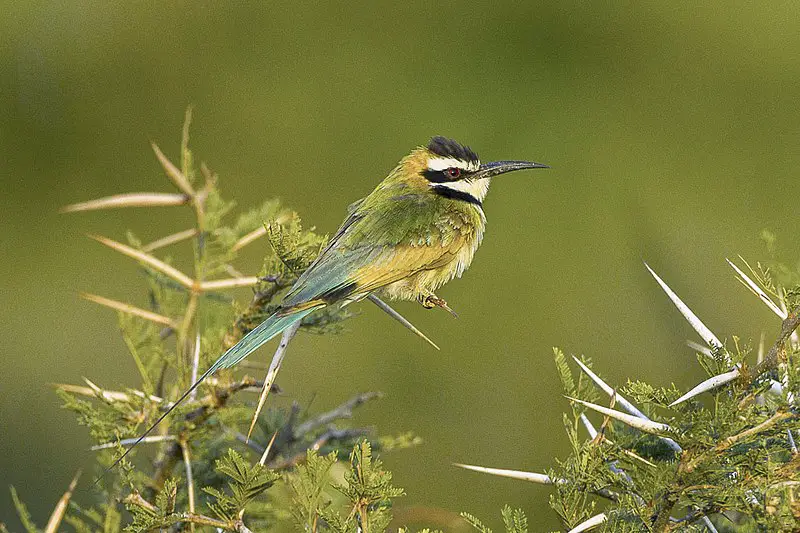
The White-throated bee-eater is a stunningly colourful bird that belongs to the Meropidae family in the near passerine category.
It breeds in semi-desert regions along southern Sahara and migrates during winter months to equatorial rain forests from Senegal to Uganda, where it enjoys different habitat experiences.
Its plumage consists of bright blues, greens and yellows with a distinctive white throat patch which gives it its name.
They feed on insects such as bees, dragonflies and wasps by catching them mid flight or plucking them off vegetation before returning back to their perch spot for eating; they perform aerial acrobatics while hunting.
These birds are social creatures who form colonies when breeding season arrives around springtime.
Their nests consist of tunnels dug up into sandy banks or termite mounds lined with grasses providing protection against predators like snakes and monitor lizards making this species an excellent example of adaptation in nature.Scientific classification:
| Kingdom | Animalia |
| Phylum | Chordata |
| Class | Aves |
| Order | Coraciiformes |
| Family | Meropidae |
| Genus | Merops |
| Species | M. albicollis |
19. Lichtenstein’s Sandgrouse
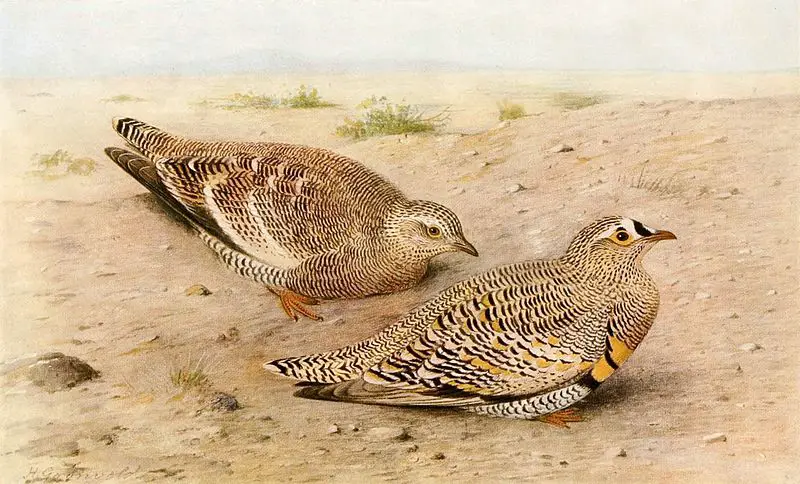
Lichtenstein’s sandgrouse is a species of bird found in various parts of Africa and the Middle East.
Its range stretches from Kenya near the equator to Afghanistan, with stops in Algeria, Chad, Djibouti, Ethiopia and Somalia along the way.
These birds are nomadic creatures who mostly come out at night; they drink water before dawn or after dusk.
The species was named for its discoverer Martin Lichtenstein who first described it back in 1823. They live mainly on seeds but also consume insects such as grasshoppers or termites if necessary for survival purposes.
Sandgrouses make their nests directly on bare ground where there’s minimal vegetation – usually dry deserts or semi-desert areas – although some can be spotted occasionally even in wetter habitats like riverbanks too.Scientific classification:
| Kingdom | Animalia |
| Phylum | Chordata |
| Class | Aves |
| Order | Pterocliformes |
| Family | Pteroclidae |
| Genus | Pterocles |
| Species | P. lichtensteinii |
Also Featured In: Common Birds of Socotra,
20. Black-Crowned Sparrow-Lark
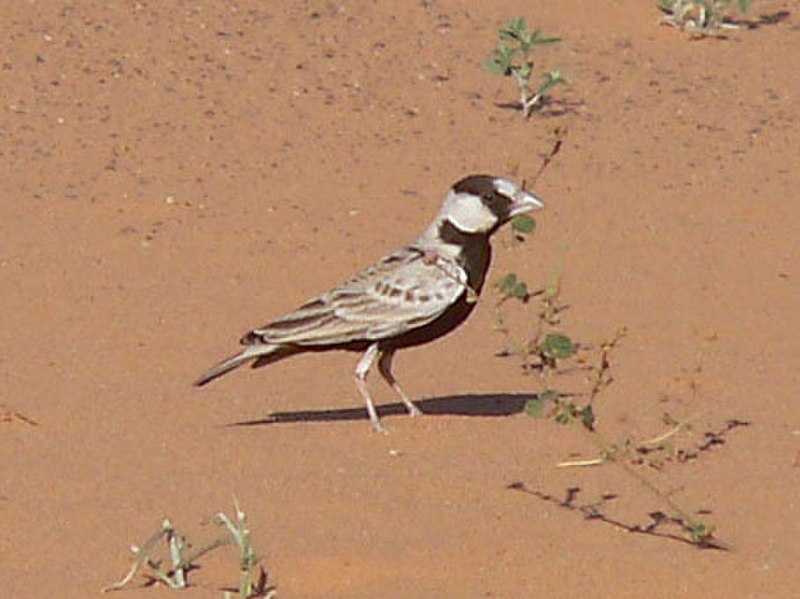
The black-crowned sparrow-lark is a species of lark found in northern Africa, the Middle East and north-western India. It resides in dry savanna habitats where it can be seen foraging for food on the ground.
The bird has an impressive white crest with distinctive black crown feathers that are only visible when viewed from above or behind.
Its brown upper parts mingle with its whitish underparts to provide excellent camouflage against predators, while its long legs allow it to run quickly across open fields if necessary.
Overall, this interesting little bird provides a fascinating sight as it hops around looking for food and flying through the air with grace and agility.Scientific classification:
| Kingdom | Animalia |
| Phylum | Chordata |
| Class | Aves |
| Order | Passeriformes |
| Family | Alaudidae |
| Genus | Eremopterix |
| Species | E. nigriceps |
21. Rüppell’s Warbler
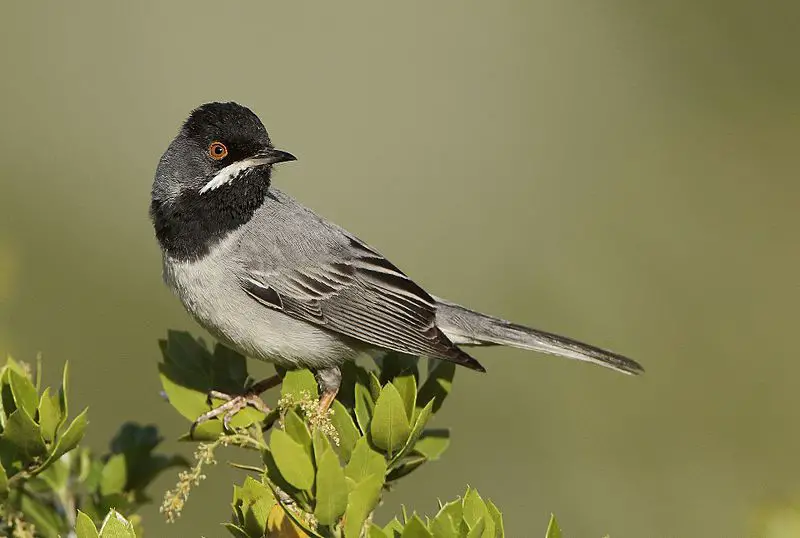
Rüppell’s warbler is a species of small passerine bird that belongs to the genus Curruca. It breeds in southern Europe, particularly in Greece and Turkey, before migrating south for wintering grounds in northeast Africa.
The adult plumage is plain greyish-brown above with whitish underparts; they have a slim figure compared to other birds of their family like the Sardinian Warbler.
Ruppel’s Warblers are generally shy but can be attracted by playing tapes containing recordings of their songs or calls.
Though rare, these birds may occasionally appear as vagrants on western European shores – making them an exciting sighting.
They typically inhabit open woodlands near water sources such as rivers and streams, where they feed mainly on insects gleaned from foliage or taken midair during hawking flights while singing enthusiastically throughout summer mornings.Scientific classification:
| Kingdom | Animalia |
| Phylum | Chordata |
| Class | Aves |
| Order | Passeriformes |
| Family | Sylviidae |
| Genus | Curruca |
| Species | C. ruppeli |
Also Featured In: Common Algerian Birds , Common Birds of Lesbos Island
22. Tropicbirds
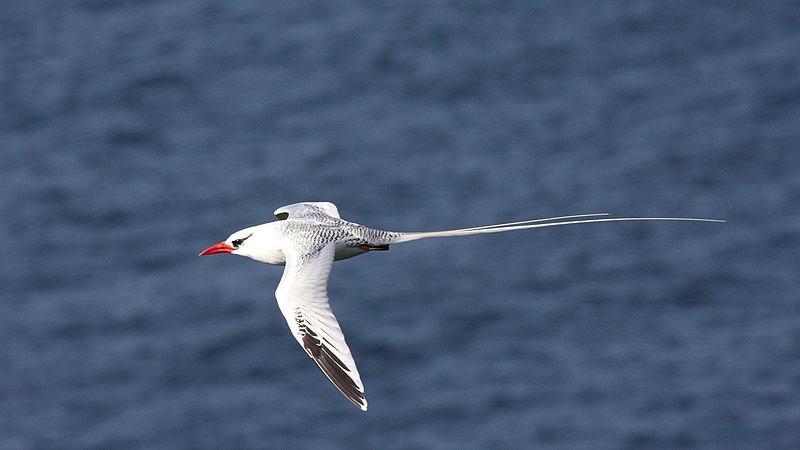
Tropicbirds are a unique family of birds, belonging to the order Phaethontiformes. They have long, white tail feathers and bright-colored beaks.
These features make them easily recognizable from other bird species.
Tropicbirds live in tropical seas throughout the world where they feed on fish and squid near coral reefs or ocean surface waters.
They breed mainly on remote islands with few predators, nesting their eggs in crevices or burrows dug into sandy soil by both parents for about five weeks until hatching takes place.
When not breeding tropicbirds can travel up to 10 000 km over several months before returning home again.
Their beauty is remarkable – so if you ever get a chance to see one of these magnificent birds flying gracefully above the sea then take it as an opportunity not to be missed.Scientific classification:
| Kingdom | Animalia |
| Phylum | Chordata |
| Class | Aves |
| Clade | Eurypygimorphae |
| Order | Phaethontiformes Sharpe, 1891 |
23. Lesser Masked Weaver
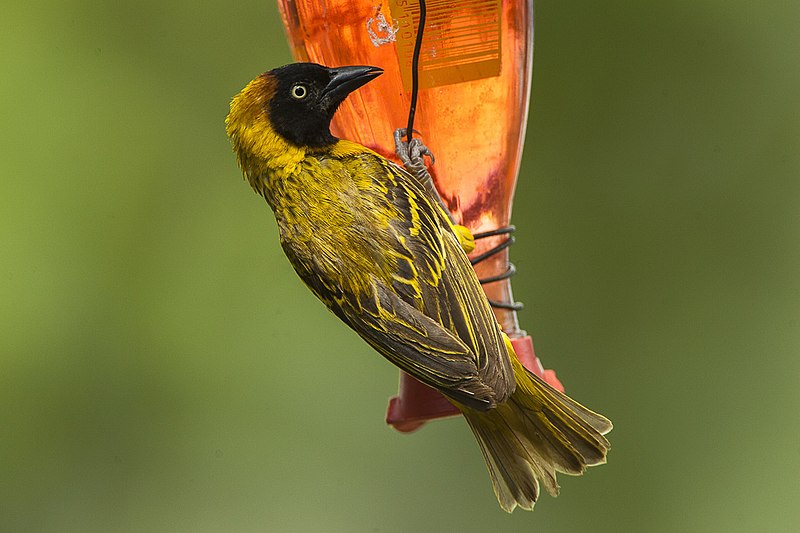
The Lesser Masked Weaver is a species of bird found in eastern, south-eastern and southern Africa.
It has two different subspecies which build their nests in large colonies often alongside the Village Weaver and sometimes Red-billed Buffalo Weavers.
These birds are commonly parasitised by Diederik Cuckoos due to its habit of nesting close together with other weaver families.
The male weavers have bright yellow feathers on their heads along with black eyes while the females have brownish plumage that helps them blend into their environment better for protection from predators.
They feed mainly on insects, seeds, berries and flower buds but can also take advantage of human sources such as agricultural fields or garden vegetation when available nearby.
Overall this small yet vibrant bird brings life to any area it inhabits making it an almost universally loved avian friend.Scientific classification:
| Kingdom | Animalia |
| Phylum | Chordata |
| Class | Aves |
| Order | Passeriformes |
| Family | Ploceidae |
| Genus | Ploceus |
| Species | P. intermedius |
Also Featured In: Birds of Etosha National Park,
24. Somali Sparrow
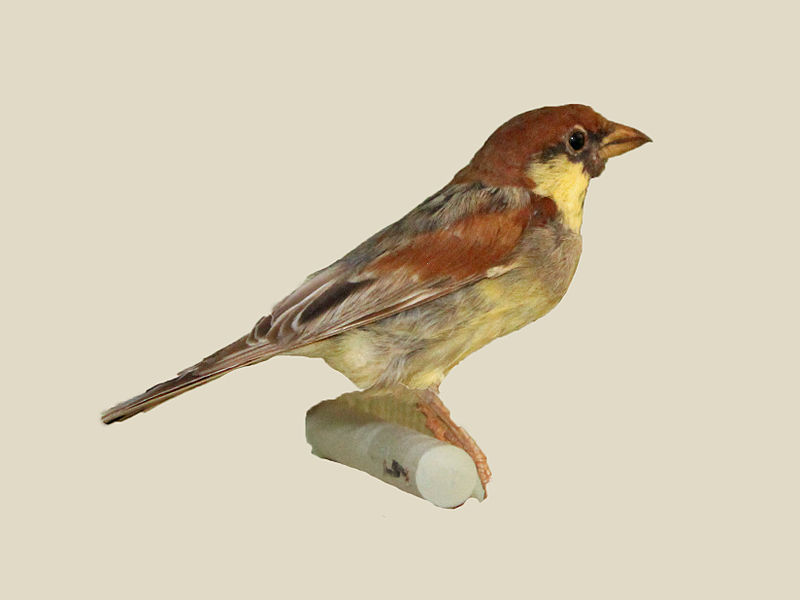
The Somali sparrow is a species of bird that can be found in Somaliland, Djibouti, Ethiopia and Kenya.
It shares many characteristics with the russet sparrow but these similarities are thought to have come from convergent evolution rather than being related by lineage.
The Somali sparrow has grey-brown upperparts which contrast nicely against its cream under parts. Its wings are blackish brown while its tail is dark grey with white patches at the base of each feather.
Its bill is also light grey and it has a beautiful buff coloured forehead rounded off with an orange crown patch on top of its head.
This small yet striking bird will make for quite a sight when spotted amongst foliage.Scientific classification:
| Kingdom | Animalia |
| Phylum | Chordata |
| Class | Aves |
| Order | Passeriformes |
| Family | Passeridae |
| Genus | Passer |
| Species | P. castanopterus |
25. Arabian Warbler
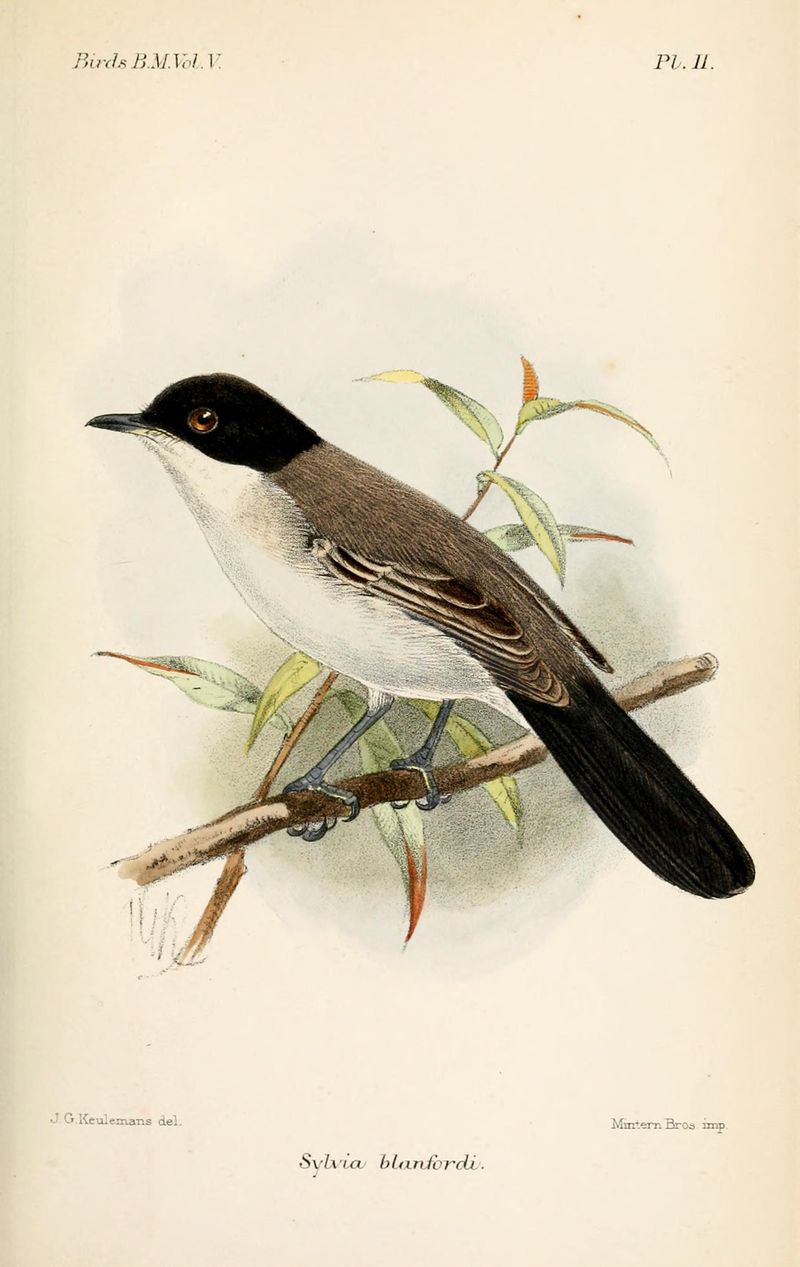
The Arabian Warbler is a species of Old World warbler found in Djibouti, Egypt, Eritrea, Israel, Jordan, Oman and Yemen.
It has four recognized subspecies: C. l. negevensis ,C. l. leucomelaena ,C .l edithae and C .l rufiventris which all inhabit dry savanna country dotted with Acacia trees typically found on the banks of rivers or near oases across its range countries.
The bird is quite small measuring only 9cm long when fully grown with males having greyish plumage while females have duller brown feathers although both genders feature reddish wings as well as tawny-buff underparts making it easy to spot them amongst the foliage they call home.
They are known for their melodic song which can be heard throughout summer months but during winter they migrate southwards to Africa where temperatures are more mild this behaviour helps ensure that new generations continue to thrive despite harsh desert conditions.Scientific classification:
| Kingdom | Animalia |
| Phylum | Chordata |
| Class | Aves |
| Order | Passeriformes |
| Family | Sylviidae |
| Genus | Curruca |
| Species | C. leucomelaena |
26. Black-Crowned Tchagra
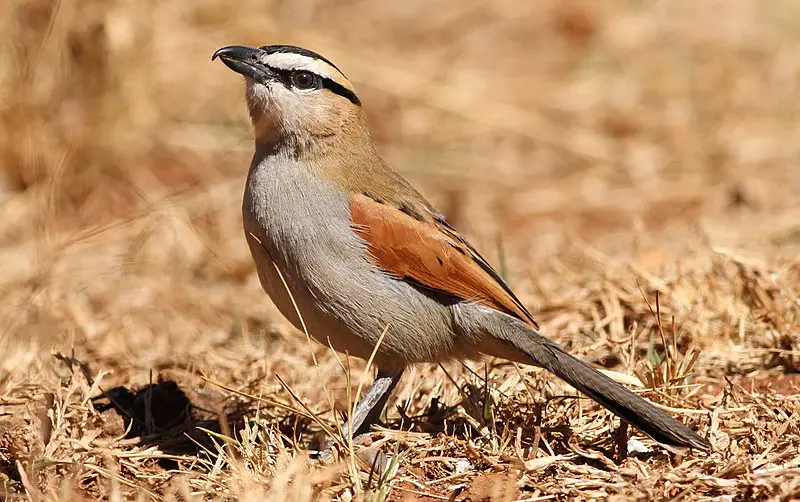
The Black-crowned Tchagra is a bushshrike found in the Arabian peninsula and most of Africa. It inhabits scrub, open woodland, semi-desert and cultivation areas.
This species has distinctive black crown feathers on its head with brown wings and tail that have white stripes running through them.
Its breast is mottled greyish-brown while its throat and belly are off white or pale yellow in colouring making for an attractive bird to behold.
The French zoologist Mathurin Jacques Brisson first described this bird back in 1760 as part of his encyclopedic ornithological work ‘Oiseaux’ (Birds).
Whether you live near the Sahara Desert or not, it can be fun to observe these birds during their active times so keep your eyes peeled.Scientific classification:
| Kingdom | Animalia |
| Phylum | Chordata |
| Class | Aves |
| Order | Passeriformes |
| Family | Malaconotidae |
| Genus | Tchagra |
| Species | T. senegalus |
27. Black Scrub Robin
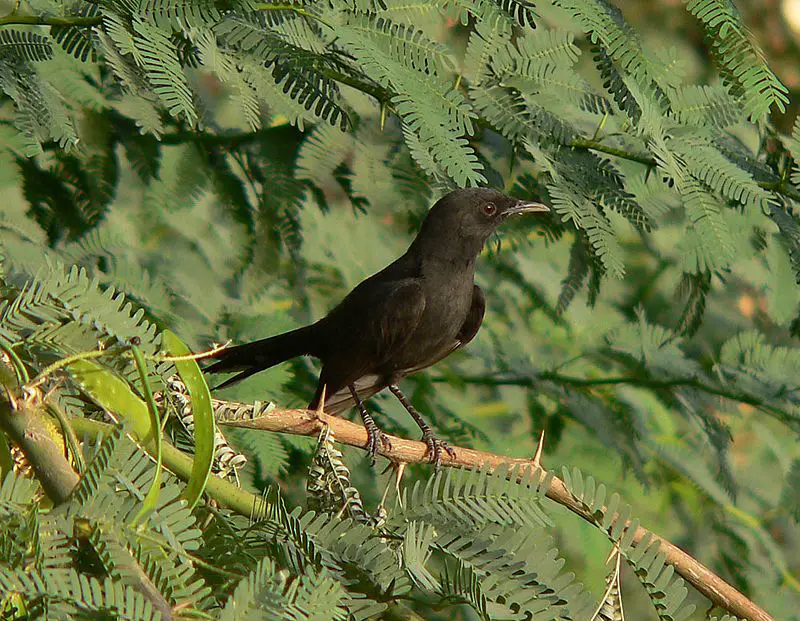
The black scrub robin is a small bird found mainly in the Middle East and Africa. It has grey-brown plumage with white spots on its wings and tail, while its underparts are pale yellowish-white.
Its habitat consists of dry savannas where it can easily find insects to feed upon. In Riyadh, KSA, this species was first spotted back in 1992 when several individuals were seen foraging around grassland areas near the city center.
Unfortunately due to urbanization the habitats suitable for these birds have been quickly diminishing leading to their decline in numbers throughout most of their range countries over recent years.
Conservation efforts such as creating protected reserves must be implemented if we want our future generations to witness these beautiful creatures among us again.Scientific classification:
| Kingdom | Animalia |
| Phylum | Chordata |
| Class | Aves |
| Order | Passeriformes |
| Family | Muscicapidae |
| Genus | Cercotrichas |
| Species | C. podobe |
28. Abyssinian White-Eye
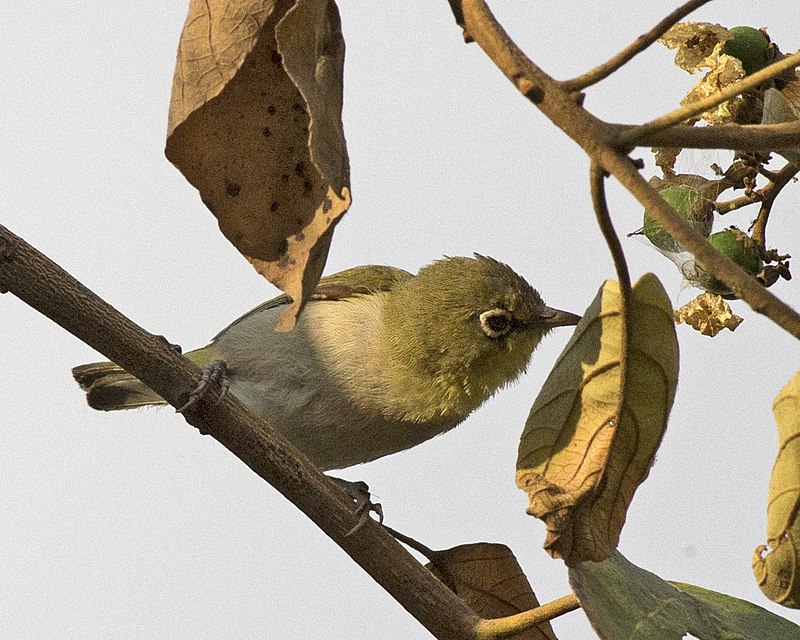
The Abyssinian white-eye is a small passerine bird belonging to the family Zosteropidae and native to north-east Africa and southern Arabia. It measures 10–12 cm in length, with green upperparts which are darker and greyer in northern races.
On its face there’s a narrow white ring around the eye set against black line between bill and eye. The underparts are whitish or pale yellow depending on subspecies; wings grayish brown with two faint wing bars, tail short forked forming V shape when closed during flight.
This species can be found in woodlands, grassland scrub as well from sea level up to 3200 m altitude according to habitat availability.
It feeds mostly on insects but also takes some fruits like figs or berries; it has adapted easily to human presence so it can often be seen near rural houses looking for food scraps too.
An interesting fact about this lovely creature is that males defend their territories by singing at dawn , however they don’t do it all year round only seasonally if necessary.Scientific classification:
| Kingdom | Animalia |
| Phylum | Chordata |
| Class | Aves |
| Order | Passeriformes |
| Family | Zosteropidae |
| Genus | Zosterops |
| Species | Z. abyssinicus |
29. Blue-Naped Mousebird
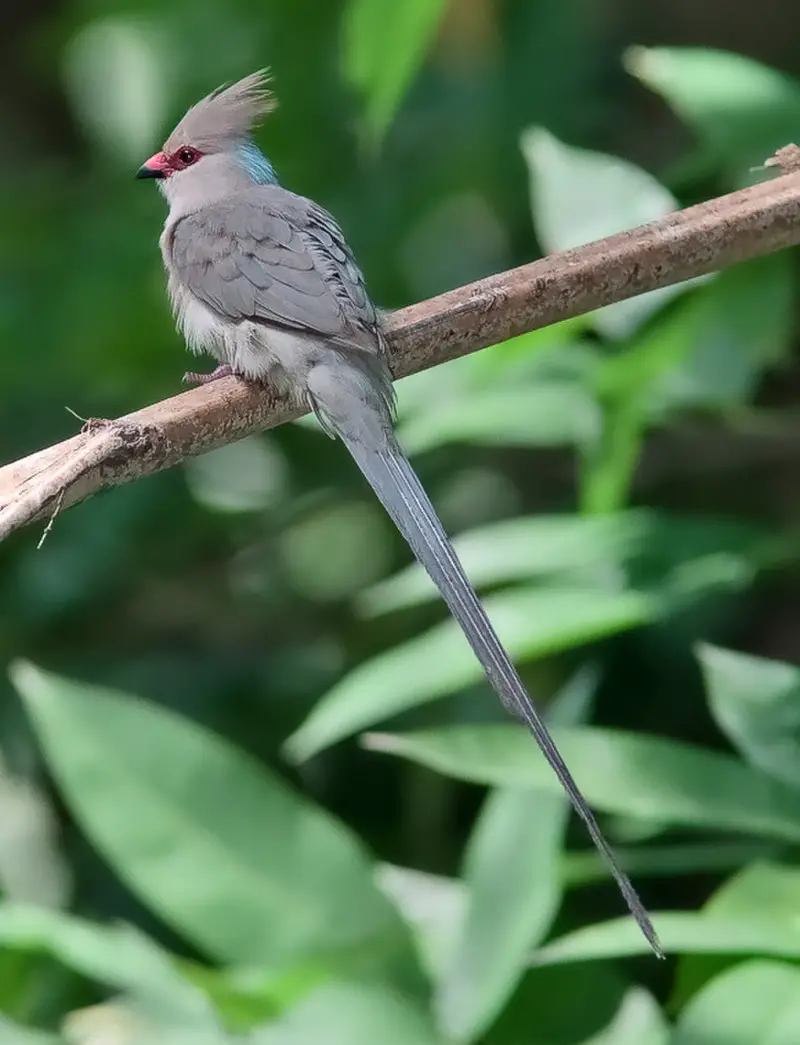
The Blue-naped mousebird (Urocolius macrourus) is a small bird found in the dry regions of East Africa.
It belongs to the six species of Mousebirds and its name comes from its habit of running along branches, similar to those of a scurrying mouse.
The distinctive blue nape plumage on their neck gives them their common name – it can be seen during flight or when they are perched atop trees.
They have long tails that help them balance while moving around tree branches quickly and efficiently. These birds feed mostly on seeds, fruits, buds and leaves from various plant sources but will also eat insects occasionally for extra nutrition.
Their diet helps spread pollen between plants which aids with pollination and contributes towards maintaining healthy ecosystems across African environments where these birds live.Scientific classification:
| Kingdom | Animalia |
| Phylum | Chordata |
| Class | Aves |
| Order | Coliiformes |
| Family | Coliidae |
| Genus | Urocolius |
| Species | U. macrourus |
30. Arabian Golden Sparrow
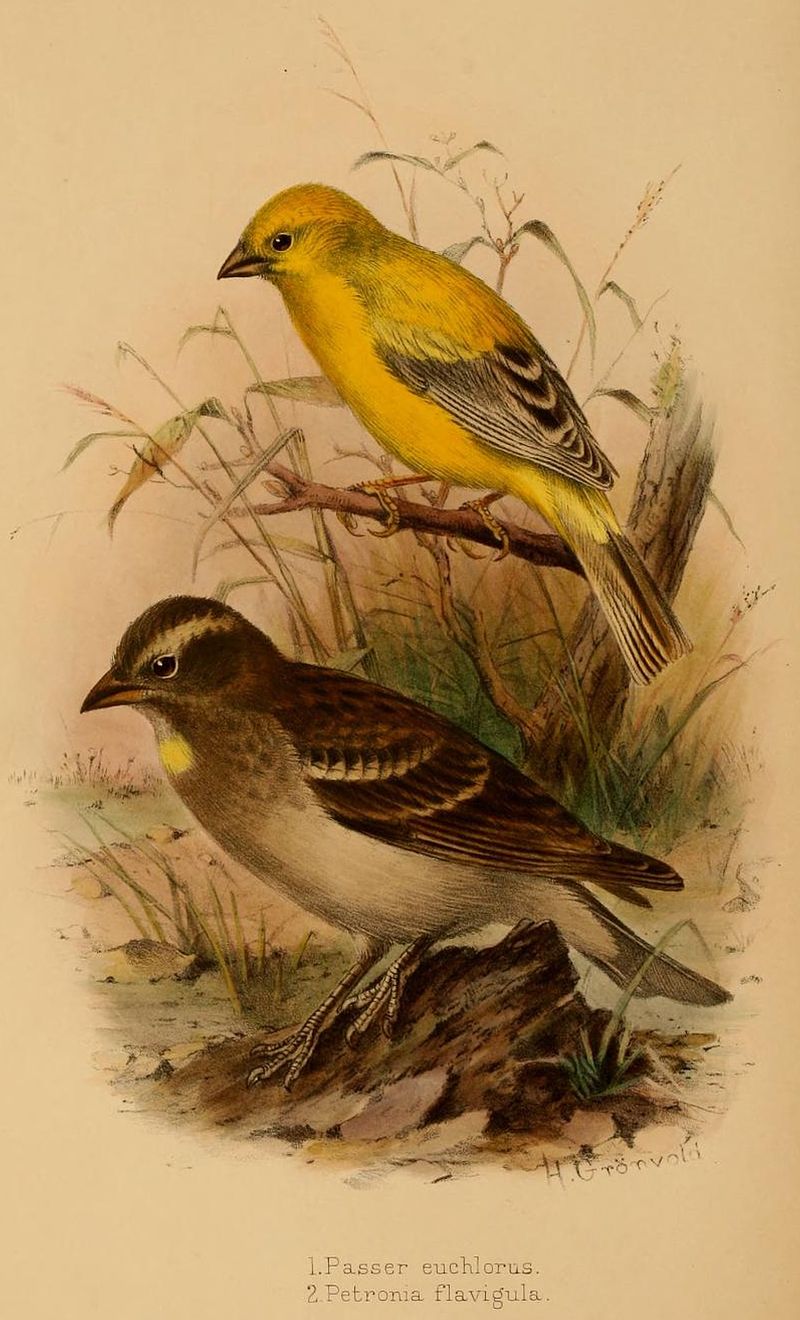
The Arabian golden sparrow is a small, seed-eating bird native to south west Arabia, Somalia and Djibouti. It lives in thorn savannahs and scrub habitats which provide it with plenty of food sources.
Its striking colouration makes it stand out from other birds – gold feathers on its back give way to white ones on the underside. The wings are also tipped in black making them easy to spot when they take flight.
While similar species have been found elsewhere in Africa, this particular subspecies is only known from these three countries where populations remain steady but vulnerable due to their limited range size.
Conservation efforts should focus on protecting suitable habitat for the Arabian golden sparrow so that future generations can enjoy this beautiful creature’s presence as much as we do today.Scientific classification:
| Kingdom | Animalia |
| Phylum | Chordata |
| Class | Aves |
| Order | Passeriformes |
| Family | Passeridae |
| Genus | Passer |
| Species | P. euchlorus |
31. Rüppell’s Weaver
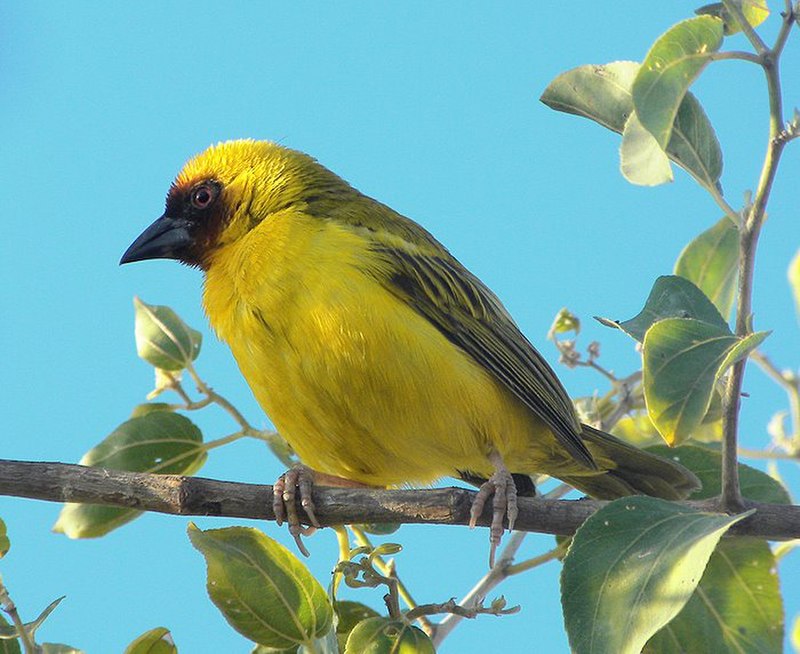
Rüppell’s weaver is a species of bird in the Ploceidae family, native to northern Afrotropics. It was named after German zoologist and explorer Eduard Rüppell.
The range for this species includes Sudan, Somalia and extreme northern Kenya, as well as the south-western Arabian Peninsula.
In Degua Tembien mountains in north Ethiopia it can be seen at high altitudes up to 3200m above sea level.
This small bird has impressive yellowish-green plumage with dark streaks on its chest and back; males may have some orange coloration too.
Their song consists of chirps that get louder towards the end, making them easily recognizable among other members of their family.
As they are highly social birds they often flock together while nesting or feeding on insects such as grasshoppers or beetles near agricultural fields or pastures.Scientific classification:
| Kingdom | Animalia |
| Phylum | Chordata |
| Class | Aves |
| Order | Passeriformes |
| Family | Ploceidae |
| Genus | Ploceus |
| Species | P. galbula |
32. Gambaga Flycatcher
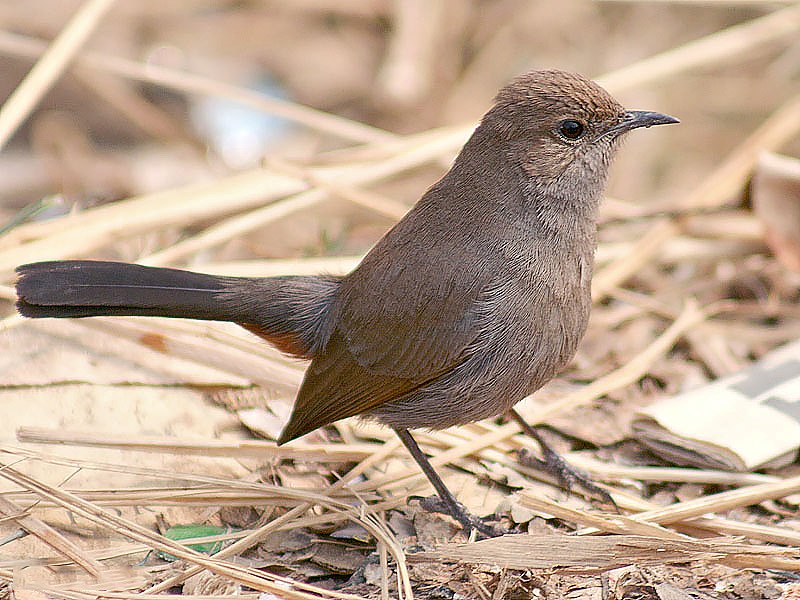
The Gambaga flycatcher is a species of Muscicapidae family, found in many countries across Africa and the Middle East.
It inhabits dry regions such as subtropical or tropical dry forests, semi-desert areas and shrubland.
Its diet consists mainly of insects collected from low vegetation. This bird has grayish-brown upperparts with white underside which helps it to camouflage well against its environment; while its face shows yellow feathers around eyes that give an impression of wearing glasses.
Male birds have more striking colors than females helping them during courtship displays.
Despite being widespread in its range, this species faces threats due to habitat destruction caused by human activities such as overgrazing and agricultural development leading to a decrease in population size.Scientific classification:
| Kingdom | Animalia |
| Phylum | Chordata |
| Class | Aves |
| Order | Passeriformes |
| Family | Muscicapidae |
| Genus | Muscicapa |
| Species | M. gambagae |
33. Grasshopper Buzzard
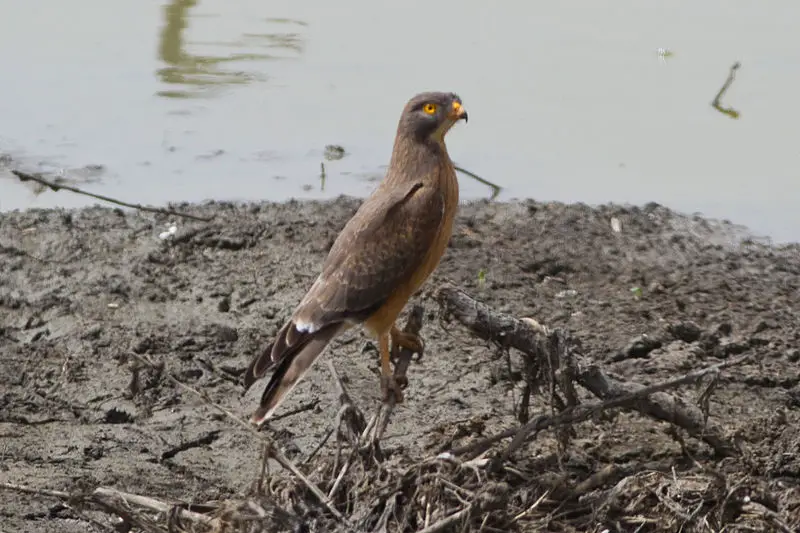
The Grasshopper Buzzard is a species of bird of prey found in sub-Saharan Africa north of the equator. It forms a superspecies with three other buzzards, all from Asia: White-eyed Buzzard, Rufous-winged Buzzard and Grey-faced Buzzard.
The adult has grey upperparts and white underparts with black streaks on its chest. Its head is dark brownish grey while its tail is pale buff barred with dark brown bands.
This medium sized raptor typically hunts grasshoppers or small rodents from a perch but may also soar high to search for prey using their keen eyesight over open country or forest edges.
They are mainly monogamous birds nesting on large trees at the edge of woodlands where they lay up to three eggs which hatch after an incubation period lasting between 28 – 32 days long by both parents taking turns feeding them food items such as frogs, lizards and insects until fledging almost six weeks later when they leave the nest independently before fully matured into adulthood when they reach two years old.Scientific classification:
| Kingdom | Animalia |
| Phylum | Chordata |
| Class | Aves |
| Order | Accipitriformes |
| Family | Accipitridae |
| Genus | Butastur |
| Species | B. rufipennis |